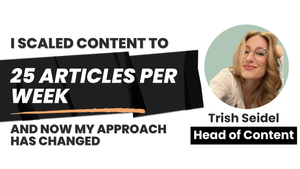Hey friends,
I had the wonderful Trish Seidel on the podcast this week.
Trish was Growth Manager at Springly in 2023 and oversaw an almighty content scale effort—from 2 to 25 articles per week.
We talked through that process, including her honest reflections now there’s space between that role and a new one.
The chat covered:
- How she got buy-in for the project
- Why they created BOFU content first
- How to design topic clusters for SaaS
Towards the end, we also shifted into Trish’s current role at Djust.
Djust’s product is more expensive. The target market is Fortune 500 companies. And the sales cycle is 6-12 months.
That’s completely different from Springly, which costs $45 and even has a free version of the product.
I asked, “How has your approach to SEO changed?”
And, let’s just say things look very different—which is a great lesson in why it's important to adapt SEO strategies and advice to your particular market, product, and audience.
You can listen to the episode here.
Here are three of my highlights from the episode:
Question: Why did you create BOFU content first?
Answer:
“All the content trickles down into something that is highly convertible, right? So the idea is to generate not just traffic, but to generate conversions, to generate revenue, not just vanity metrics.”—Trish Seidel
This is a great point. When you create your bottom-of-funnel content first, all your other content builds on top of it.
You can’t drive top and middle-of-funnel readers to convert if there are no conversion pages to link them towards.
An example of this would be to create a top-of-funnel article titled “What is keyword research?” and somewhere in the content add an internal link to another of your articles, “The best keyword research tools”.
The top-of-funnel reader may realize they need a tool and be more than happy to explore your listicle and learn about your product—but only if there's content there to read.
In the podcast, we also discussed two other benefits of producing BOFU first:
- Producing it first = Give it the longest time to rank. Nice to get it out there fast so it can accrue value.
- Harder to produce = To produce BOFU content you need to nail positioning and the way you discuss product features. That’s super useful once its done, writers forever more can refer to those guides when creating content for you.
Question: When looking back at Springly, what would do differently next time? What was the biggest mistake you made?
Answer:
“There was one point where we had kind of gone through a majority of the keywords in our sector. We had 700 articles at one point. And you get to a point where you saturate your market. There's not much else you can be doing right in terms of keywords and keyword research.
So then we had found ourselves going back and optimizing all of these 700 articles and it was incredibly painful. You know what I mean? Cause you weren't just optimizing the content. We realized that some of the formats were different. A lot of the alt tags were missing. The images were far too heavy because we weren't really focused on that at that point.
We didn't care at that moment. We were just like, we'll fix it later, right? We have to produce as much content as we can.And the kind of fix-it-later mentality is not necessarily sustainable in the long run.
It will be great for this really micro, really high hyperspeed growth, but you will plateau at one point, which is totally normal. It's how life works. It's how, you know, research works. And so going back and optimizing them was a little bit, was a lot of it painful.”
To reiterate, if you cut corners when scaling content… you’ll have to fix those corners 700 times. And you’ll wish you had done it right the first time.
Enough said.
Question: What’s different now you’re at Djust (a 6-12 month sales cycle targeting Fortune 500 size clients)?
Answer:
“We do enterprise sales. The sales cycle is extremely long between, 6 to 12 months. We're working with high-profile clients, Fortune 500 companies. And so, as you can imagine, the approach to SEO is wildly different.
It's because we're not using SEO as our primary growth tactic. And so when you're not using it as the major channel acquisition, it takes a different lens. We didn't have an inbound funnel up until recently, again, because we did enterprise sales (mostly outbound sales, events, thought leadership).
And so [with this strategy I’m building] I'm being very intentional about the content that we create and we're creating content at a much lower, slower rate.
We're creating about eight articles per month. As you can imagine going from 25 a week, which is about a hundred a month to eight a month, the scale looks very different. The content is much more complex and it's very research focused. So we're taking information from McKinsey, from Gartner, from, you know, these really research-specific organizations.
And that's what a lot of our bottom-of-funnel content is based on. And the scale and amount of keywords that we have found [that fit out funnel] are really, really lower. We're not talking about 700 keywords anymore. We're talking about 150, so very different.”
I love these lessons. I’ve experienced exactly the same.
When targeting a senior audience at large enterprises, you have:
- Fewer keywords. This audience typically uses Google Search for only a very select number of searches, so you don’t have thousands of topics to choose from. You might have 50 keywords that represent your target market.
- Elite content needs. This audience is elite at what they do. They don’t want quick hacks and basic intro guides. They love data and research and want opinion to push their thinking forward. This is tough content to create.
Hope you enjoy the episode,
—Benny
Content You (Might Have) Missed:
- Premium: How to Write Top Tier "Best X Software" Listicles (With Template)
- Free: Top 10 SEO Tasks You Must Not Ignore
- Free: My Ultimate Design for SEO Checklist (Notion File)
- Premium: Scaling ClickUp to 100K/mo with as a 1-man content team (Josh Spilker's story)
The full backlog can be found here.


